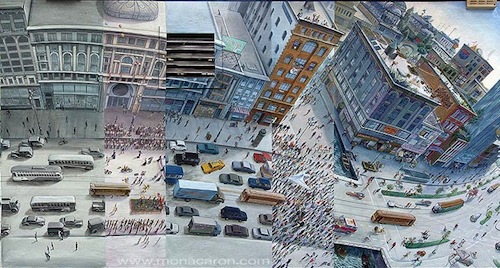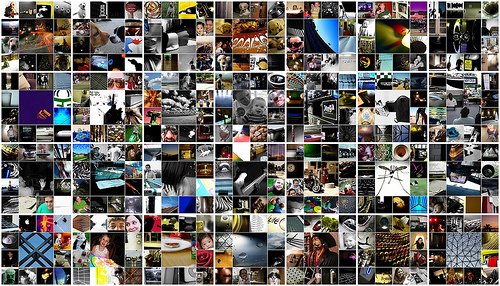“I’ll be dead by then. Shot.”
Large brown eyes stared back at me as he spoke, with a sincerity and certainty that tied my stomach in knots.
I was learning that it’s really hard talking to twelve-year olds about the future, particularly this little guy. Thinking ten years out is a stretch for many of the adults I work with at the Institute for the Future. And now my colleagues, and our collaborators at Collective Roots and East Palo Alto Charter School, had set out to help a class of seventh graders envision their futures—their actions and their surroundings—in a decade.
Most students placed themselves in their charter school’s vision of their futures: attending college, getting a job, considering careers, caring for family members (all scenes embellished richly with high-end cars). But not this guy. We went around and around trying to find a story he felt was plausible that didn’t include his untimely demise. He had witnessed enough friends and family members die in random and arbitrary situations arising from poverty and urban violence, that he considered it inevitable that he wouldn’t survive past his teenage years.
How could a child live without hope for a future? What can “resilience” possibly mean in the face of such a personal future?
Credit: Ricardo Wang
Resilience is generally defined as the ability to bounce back from disturbance and to cope with adversity. With roots in ecology, psychology and materials science, the concept has gained currency in the last few years as an alternative to clinging tight to stability, amidst rampant volatility at every scale.
Resilience builds upon foundations of sustainability, embracing the core idea of not letting the demands of the present starve the needs of the future, yet without the demand that we preserve or conserve the past. Faced with the inability to sustain our past, we reinvent ourselves for a new context. Resilience asks that we envision alternative futures—including and especially transformative ones. Resilience is intimately connected to the practice of creating futures. The Resilience Solutions Group at Arizona State University defines human resilience, in part, as a “sustainability of purpose.” It is not enough simply to bounce back: one has to bounce forward into hope and purpose.
But how do we, and my young student, create hope and purpose in the context of an uncertain and deeply unsettling reality? And how does this sense of purpose infuse large-scale systems with many diverse and evolving parts? To answer those questions, we not only need to understand the importance of imagining the future, but also how resilience hinges on the concept of diversity. IFTF Research Fellow Jamais Cascio includes it in his take on the principles found in most resilient systems, and I think it is one of the more central ones.
Diversity is a key element conferring greater resilience to collectives and communities, according to the Resilience Solutions Group. In a collective, community, or organization, diversity of roles and respect for the capacities that allow individuals to fulfill those roles is the kind of diversity associated with greater resilience. That is, people turn their difference into purpose for themselves, creating both more resilient individuals and more resilient communities.
What I propose is that we need more than this kind of diversity for a resilient future. We need diverse alternative futures. It is these alternative futures that link the resilience of individual lives to the resilience of large-scale systems. Ecologists will tell us that diversity, in the sense of biodiversity, is essential to the stability and resilience of ecosystems.
There are a number of sound hypotheses for why this is the case, but the “portfolio effect” provides an especially useful analogy. In this interpretation, biodiversity increases resilience as suites of species pursue different responses to environmental perturbation. This response diversity increases the chance that at least some responses will be effective, thus allowing the services in that ecosystem to weather disruption if not without interruption, then with quick recovery. Alternative futures ask us to discern these diversities of roles, purpose, strategy, and outcomes in our lives and all around us.
At IFTF, we most often create alternative futures with organizations: companies, government entities, professional societies, etc. We present forecasts and scenarios of the future and help our clients think through alternative strategies that would serve their organizations’ purpose within different perspectives on the future. We encourage them to consider diverse external forces as well as technological and social innovations that could transform them from within.
Key to this is the idea of purpose. For most publicly held companies, their ostensible purpose is clear: to maximize shareholder value. In a world where the major institutions of daily life—our commercial enterprises—are focused on this single-minded purpose, the task of creating resilient futures through diverse strategies has been taken up most intensely thus far by individuals on one hand and larger communities on the other.

This mural by Mona Caron imagines the past, present, and shareable future of Market Street in San Francisco. Photo by Michael Rauner Photography.
More and more communities are exploring alternative visions of the future, focusing on the services supporting everyday living. The transition town movement is an aggregation of local communities imaging new possibilities for their own futures. Alternative food production systems are exploring not only narrow bids for self-sufficiency, but also the unique strengths and boundaries of foodsheds, and the complexities of regional integration and support. Experiments in alternative currencies and manufacturing systems similarly question the wisdom of centralization, creating and evolving abundance of new roles and relationships. These visions and practices play a role in increasing the resilience of these communities and those that learn from them. Consciously creating these transformative futures is the core methodology that the foresight network Resilient Futures holds up to hasten this possibility.
And while these experiments may not supplant the institutions and organizations that have so shaped our society over the last century, they do point to transformative futures. In these futures, in order to be more resilient, organizations hew to larger and more diverse purposes than shareholder value. It is not so much that any single one of these experiments holds the key to resilience, but they add to our portfolio of responses to a turbulent future. They potentially cushion the core services of our society from disruptions, be they imminent, ongoing, or remote.
Another notable thing about all of the experiments described above is that they are futures that are collaboratively created and practiced. Numerous participants can consider more radically diverse futures than a single mind could manage. A few years ago Jason Tester and Rachel Hatch, colleagues of mine at IFTF, set out to imagine the future of care-giving with United Cerebral Palsy. It is a topic both emotionally heavy and extremely timely, and it took creativity on their part to find a way of collaboratively generating diverse alternative futures of care-giving with people who are tired, taxed for time, and too often stigmatized. They created a scenario of a fictional town that needed to learn how to care for its residents—amidst rapidly dwindling resources for public services and rampant feelings of social isolation. Suggestions poured in from all over the country, indeed internationally, for alternative forms of care-giving that give each of us new roles to play. The result was a vision of the future where the burdens of “care-giving” give way to “caring.” Distributed practices allow us to share our diverse strengths to create a more resilient way of caring for those in need.
Credit: Nothing to Hide
But that still brings us back to our young student in East Palo Alto who expects to die before he’s grown. One critical problem he’s facing is that he can’t see an alternative future. He’s locked into one view of his future. While perhaps honest with his experience, the future narrative he constructed left even less room for growth and transformation than his peers’ consensus view of their personal futures, regulated as they were by charter school, teachers, and parents. We coached all the students in imagining transformative events, considering unexpected twists, personalizing broad future forces like climate change and evolving food systems. And we kept coming back to this young man offering him what we thought might be possible alternative stories for his future. All the while we asked ourselves, “Is it possible to use the future as a way to change his future?”
Just when my colleagues and I thought he had bested us with his despair, he finished his story. He found a future he could live in. While we were helping other students with plot points and grammar and chestnuts of futurity, he wandered over to a small group of girls who were each telling their future stories in the same scenario. He finished his own story with aplomb, moving to the posh suburb of his classmates’ aspirations, working a fun and safe job, and “not smoking, doing drugs, or going to prison.” He found a transformative future, anchored not in any of the futures we offered, but in a future shared with his peers.
Thanks to Kathi Vian, Jamais Cascio, and Alex Zautra for conversations that inspired this piece.










